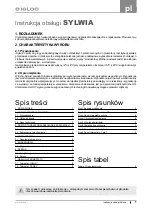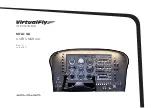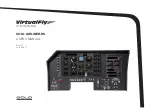
Page 3-6
GTN 625/635/650 TSO Installation Manual
Rev. C
190-01004-02
3.4
Antenna Considerations
This section contains mounting location considerations for the antennas required for the GTN units. For
mounting the GPS/SBAS antenna, refer to FAA approved data. For mounting the COM and NAV
antennas, refer to the aircraft manufacturer‘s data.
3.4.1
GPS Antenna Location
The GPS/SBAS antenna is a key element in the overall system performance and integrity for a
GPS/SBAS navigation system. The mounting location, geometry, and surroundings of the antenna can
affect the system performance and/or availability. The following guidance provides information to aid the
installer in ensuring that the most optimum location is selected for the installation of the GPS antenna.
The installation guidelines presented here meet the intent of AC 20-138A section 16. The greater the
variance from these guidelines, the greater the chance of decreased availability. Approach procedures
with vertical guidance are the most sensitive to these effects. LNAV only approaches, terminal
operations, and en route operations may also be affected. Because meeting all of these installations
guidelines may not be possible on all aircraft, these guidelines are listed in order of importance to achieve
optimum performance. Items 3 below are of equal importance and their significance may depend on the
aircraft installation. The installer should use their best judgment to balance the installation guidelines.
Figure 3-1 shows the recommended placement of antennas.
1. Mount the antenna as close to level as possible with respect to the normal cruise flight attitude
of the aircraft. If the normal flight attitude is not known, substitute the waterline, which is
typically referenced as level while performing a weight and balance check.
2. The GPS antenna should be mounted in a location to minimize the effects of airframe
shadowing during typical maneuvers. Typically mounting farther away from the tail section
reduces signal blockage seen by the GPS antenna.
3a. The GPS antenna should be mounted no closer than two feet from any VHF COM antenna or
any other antenna which may emit harmonic interference at the L1 frequency of
1575.42 MHz. An aircraft EMC check (reference VHF COM interference check in Post
Installation Checkout procedures) can verify the degradation of GPS in the presence of
interference signals. If an EMC check reveals unacceptable interference, insert a GPS notch
filter in line with the offending VHF COM or the (re-radiating) ELT transmitter.
Note
: When mounting a combination antenna (ex. GPS and COM, GPS and XM), the
recommended distance of two feet or more is not applicable to the distance between the
antenna elements provided the combination antenna is TSO authorized and has been
tested to meet Garmin‘s minimum performance standards.
3b. The GPS antenna should be mounted no closer than two feet from any antennas emitting more
than 25 watts of power. An aircraft EMC check can verify the degradation of GPS in the
presence of interference signals.
3c. To achieve the best possible low-elevation antenna gain (by minimizing pattern degradation
due to shadowing and near-field interaction), the GPS antenna must be mounted with clearance
from other antennas, including passive antennas such as another GPS antenna or XM antenna.
When practical, installers will use 12 inch center-to-center spacing between antennas. If 12
inch spacing is not practical, installers will use the maximum center-to-center spacing from
adjacent antennas, but never less than 9 inch center-to-center spacing. Spacing less than 9
inches center-to-center results in unacceptable GPS/SBAS antenna pattern degradation.
4. To maintain a constant gain pattern and limit degradation by the windscreen, avoid mounting
the antenna closer than 3 inches from the windscreen.
5. For multiple GPS installations, the antennas should not be mounted in a straight line from the
front to the rear of the fuselage. Also varying the mounting location will help minimize any
aircraft shading by the wings or tail section (in a particular azimuth, when one antenna is
blocked the other antenna may have a clear view).
Содержание GTN 635
Страница 1: ...190 01004 02 January 2012 Rev C...
Страница 2: ......
Страница 34: ...Page 2 2 GTN 625 635 650 TSO Installation Manual Rev C 190 01004 02 This page intentionally left blank...
Страница 46: ...Page 3 12 GTN 625 635 650 TSO Installation Manual Rev C 190 01004 02 This page intentionally left blank...
Страница 132: ...Page 6 52 GTN 625 635 650 TSO Installation Manual Rev C 190 01004 02 This page intentionally left blank...
Страница 134: ...Page 7 2 GTN 625 635 650 TSO Installation Manual Rev C 190 01004 02 This page intentionally left blank...
Страница 136: ...Page A 2 GTN 625 635 650 TSO Installation Manual Rev C 190 01004 02 This page intentionally left blank...
Страница 146: ...Page B 10 GTN 625 635 650 TSO Installation Manual Rev C 190 01004 02 This page intentionally left blank...
Страница 148: ...Page C 2 GTN 625 635 650 TSO Installation Manual Rev C 190 01004 02 This page intentionally left blank...
Страница 153: ...GTN 625 635 650 TSO Installation Manual Page C 7 190 01004 02 Rev C Figure C 5 GTN 6XX Connector Layout Detail Rear View...
Страница 154: ...Page C 8 GTN 625 635 650 TSO Installation Manual Rev C 190 01004 02 This page intentionally left blank...
Страница 156: ...Page D 2 GTN 625 635 650 TSO Installation Manual Rev C 190 01004 02 This page intentionally left blank...
Страница 177: ...GTN 625 635 650 TSO Installation Manual Page D 23 190 01004 02 Rev C Figure D 13 Audio Panel Interconnect Sheet 1 of 2...
Страница 190: ...Page D 36 GTN 625 635 650 TSO Installation Manual Rev C 190 01004 02 Not Used Figure D 24 Reserved...
Страница 195: ......
Страница 196: ......








































